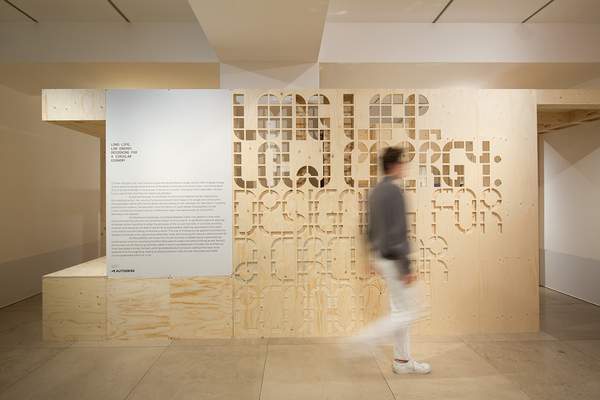A Hand's Turn
2017 - Performance (Performance)
Lenio Kaklea
During the performance A Hand’s Turn visitors are invited to read a text: “I hold a pen with the right hand / move the mouse with the right hand” reads one excerpt. While reading through the instructions the performer’s hands go through a precise choreography. The performance lasts 30 minutes and includes only 2 people at a time. Lenio Kaklea refers to a world guided by oppositions that are obsolete notions today: nature and culture, men and women, public and private, arts and science. Growing up in a communist family in exile, she was raised among questions of left and right. Informed by Psychoanalysis, feminism and the history of performing arts, the artist holds up a mirror throughout the dance segment of the performance. Through this she invokes performance art from the 60s and 70s as well as Surrealist photography. As a dancer Kaklea grew up with the mirror as an instrument of control, in the way it’s used in traditional dance, but here she uses it here a tool of emancipation and empowerment.
Lenio Kaklea is a dancer, choreographer and writer. She trained at the National Conservatory of Contemporary Dance in Athens (SSCD) before moving to France in 2005 on the Pratsika Foundation Prize, where she studied at the CNDC in Angers (FAC). Here she began to collaborate with prominent figures of the European dance scene such as Boris Charmatz, Alexandra Bachzetsis, Claudia Triozzi, Emmanuelle Huynh and Lucinda Childs. Since 2009, Lenio Kaklea has been developing choreographic projects using a range of media including dance, performance, text and film. Her work focuses on the organization of repetition in transmission in order to investigate the production of subjectivity in the peripheries. An important strand of her work is the project Practical Encyclopaedia (2016-2019); travelling different peripheral European territories she collected close to 600 local stories that recount the specificity of their identity.
Colors:
Related works sharing similar palette

© » KADIST
Asli Çavusoglu
2020In the exhibition Pink as a Cabbage / Green as an Onion / Blue as an Orange , Asli Çavusoglu pursues her work on color to delve into an investigation into alternative agricultural systems and natural dyes made with fruits, vegetables, and plants cultivated by the farming initiatives she has been in touch with...

© » KADIST
Saâdane Afif
2005In this work, Saâdane Afif quotes André Cadere’s round wooden batons using the copy share and remix principles...

© » ARTS EQUATOR
The working processes of artists: Sabrina Poon | ArtsEquator Thinking and Talking about Arts and Culture in Southeast Asia Articles April 27, 2020 Singaporean filmmaker Sabrina Poon, better known as Spoon, talks about her work and the value of storytelling by breaking down three of her short films – Sylvia , Hello Uncle and Pa ...
© » KADIST
Rabih Mroué
2012The Pixelated Revolution is a lecture-performance by artist Rabih Mroué about the use of mobile phones during the Syrian revolution...

© » KADIST
Laura Gannon
2017The impressionistic surface of Wild Money (2017) recalls the 1950s paintings of Philip Guston...

© » TATE EXHIBITIONS
Long Life, Low Energy: Designing for a Circular Economy | Tate Liverpool An exhibition from the Royal Institute of British Architects about the climate emergency and its relation to architecture Tate Liverpool and the Royal Institute of British Architects (RIBA) are forming a new partnership on Liverpool’s waterfront...

© » KADIST
Taiyo Kimura
2011In Permanent Laughter (2011), dozens of portable compasses are scattered under a sheet of acrylic board, which is in turned covered with what appear to be the diffuse remains of an unidentified skeleton...

© » KADIST
Margo Wolowiec
2017Imagine How Many by Margo Wolowiec is a woven polyester depiction of blurred text and floral images found on social media, distorted beyond complete recognition...

© » ARTS EQUATOR
Latiff Mohidin’s “Langkawi”: The Within and Beyond | ArtsEquator Thinking and Talking about Arts and Culture in Southeast Asia Articles Image: Chan + Hori Gallery July 10, 2018 By Gerald Sim (1,500 words, eight minute read) As with any thought-provoking installation, Latiff Mohidin’s “Langkawi” series, on show at Chan+Hori Contemporary , evokes a large range of perceptions from its audience...

© » KADIST
Taiyo Kimura
The wall installation Friction/Where is Lavatory (2005) plays off anxieties about time but utilizes sound to create a disconcerting experience of viewership: comprised of dozens of wall clocks sutured together, the work presents a monstrous vision of time at its most monumental...










